|
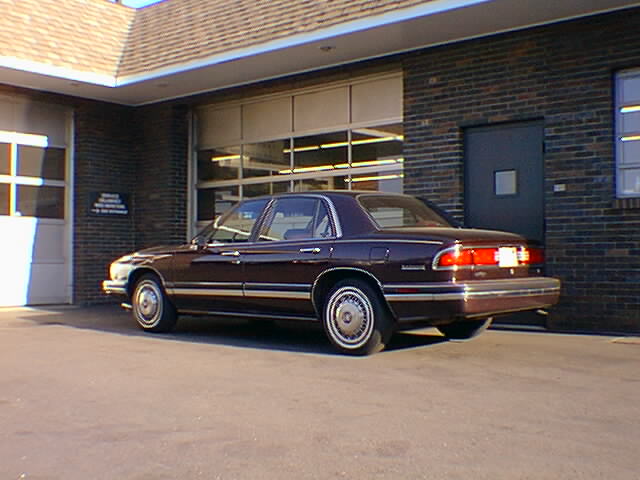
Side view of the Buick.

This is where the OBD connector is located. How convenient
for it to interfere with the brake pedal. Road testing with the scan
tool connected will definitely test your driving skills.
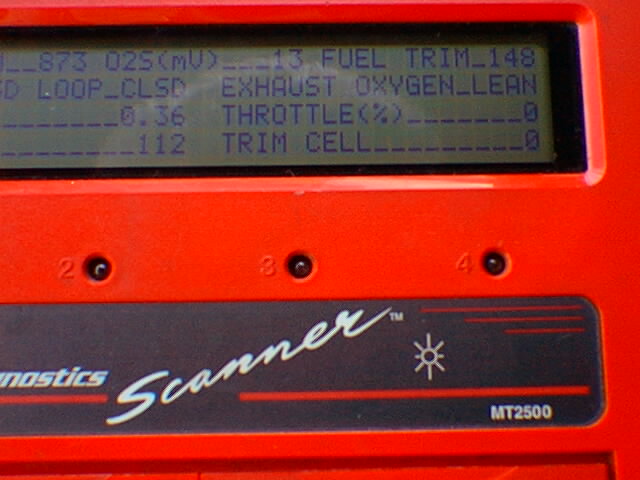
Fuel trim out of control. With fuel trim already at 148 the O2
sensor is still showing only 13 mV.
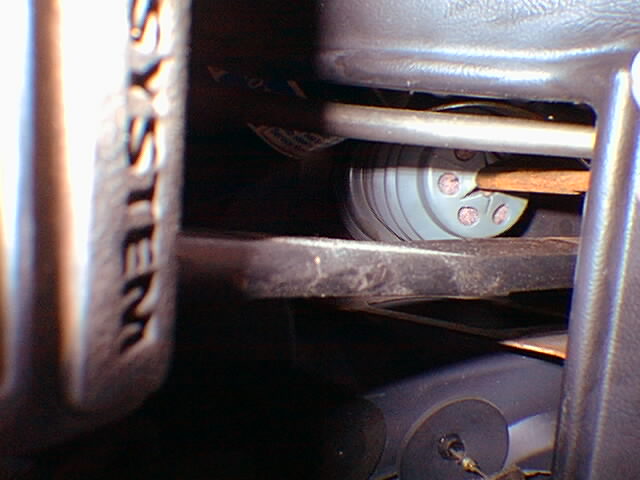
The vacuum leak was heard here at the pedal push rod boot.
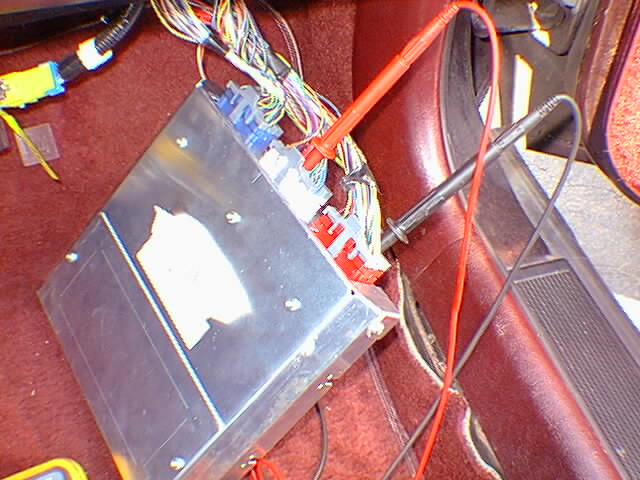
Here is a view if the Buick's ECM being back probed after
being taken down from its hiding place behind the dash.
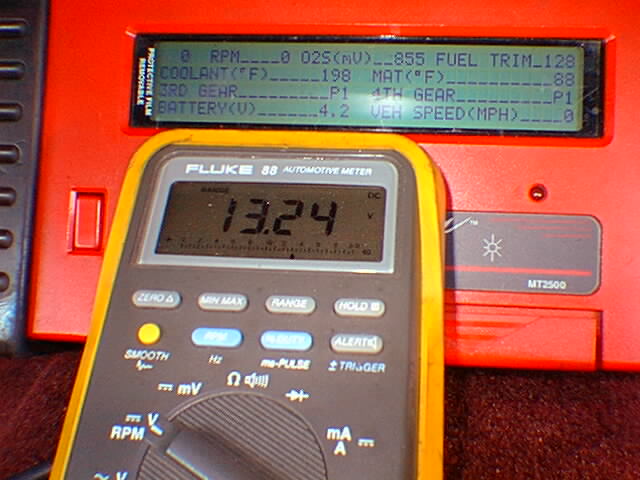
Notice the datastream is showing ECM internal voltage at 4.2
V. The volt meter clearly shows the ECM was receiving proper charging
system voltage.
|
Phantom Stall
By Mark Giammalvo, Contributing Editor
Vehicle : 1994 Buick LeSabre Custom
Powertrain: 3.8 Liter 6 cylinder 4Spd. A/T
Mileage: 117,061
Symptom: Intermittent stalling and rough running
Probably one of the worst service problems you will ever encounter is a
vehicle with an intermittent problem. Worse yet, a vehicle with an
intermittent stall condition. In fact, not many other problems will
upset a customer more than a car that intermittently stalls. Several
years back, General Motors coined the phase: "Phantom Stall" to describe
this condition. I am still amazed at the American cars today that still
have this problem. I have often wondered why the Asian and German cars
we see in the shop rarely develop intermittent stalling. It could be
just a coincidence. Then again, it might be better engineering of
critical engine management sensors and their related wiring.
It all started with one of our long time customers. A 70-year-old female
whose Buick has been stalling about every 4-5 months over the past two
years. We have driven, inspected and tested systems and subsystems on
this car during that time frame. Typically, as with intermittents, this
car will rarely become symptomatic while it is with us for service. It
has always started normally and ran well after the tow truck has dropped
it here. I must say, this customer has the patience of a saint. Some
customers get angry when we tell them we are not sure what to repair
since we cannot duplicate the problem. I have had people actually walk
out of our service department due to their refusal to understand the
complexity and time needed to diagnose some of these problems. A friend
at a Buick dealership suggested we replace the crank sensor and ignition
module. I have never been comfortable replacing parts on a shotgun
approach. In addition, it is difficult to tell a customer: "I'm going to
make some trial repairs at around 450.00, but remember, it might not
solve the problem." Then again, some would say: "I didn't build it, buy
it, or break it."
The customer had really been frightened by this recent stall event. The
vehicle had stalled out right smack in the middle of a busy
intersection. Although she was very patient and understanding, she was
getting near wit's end with this car. As usual, I was able to start the
car right off the tow truck. The customer also added that the car seemed
to run strange whenever she was descending a hill or steep grade. The
customer told me to drive it as long as needed to attempt to duplicate
the stalling. Well, lets just say I lost count after 10 lengthy test
drives. This car was running exceptionally well for a 117,000 mile car.
Finally, later in the week, the car did reveal some clues to its
ailments. Although the car never stalled for me, I was able to duplicate
the customer's complaint of trouble on steep grades. At the end of a
hilly decent, the engine seemed to be running rough. Then, at the end of
the decent, the engine would clear out and run normally. It did not seem
to be as rough as an ignition problem. To me, it felt more like a fuel
mixture change. My first thought was a mis-positioned fuel strainer or
leaking MAF intake hose. The MAF hose inspection did not reveal anything
and I did not exactly have enough test data to warrant dropping the fuel
tank. As I drove the car more, I noticed that the rough running
condition did not always relate to a hilly decent. The car seemed to be
developing a pattern of running rough during any significant braking
event. By significant braking event I mean the long brake pedal
application associated with ending a steep decent or any quick stop on
level pavement that required more than normal braking time and force.
Could the rough running be related to a brake problem? If so, that would
be a new one on me. It was time to look at scan data.
A Pattern Emerges
Although no codes were present, the scan data revealed some interesting
information. Every time I applied moderate to heavy brake pedal
pressure, the O2 sensor's value would swing lean. Now to many, this will
not come as a great surprise. Many technicians will check an idling
engine's O2 sensor's response by pumping the brake pedal quickly at a
stop. Normally, the O2 sensor will quickly swing lean as the additional
brake booster air is inhaled into the intake manifold. Then, within a
few seconds, the ECM will correct this lean condition by enriching fuel
mixture, thus resulting in an O2 sensor swing to rich. The datastream
values on this Buick were not exactly mimicking typical textbook fuel
correction values. It seemed that the longer I held down the brake
pedal, the longer the O2 sensor would report lean. At first I thought
the O2 sensor might be lazy when reporting the lean to rich transitions.
A subsequent O2 sensor test proved the sensor to be working normally.
Further analysis of the datastream revealed more to the story. As the
brake pedal was held down, not only did the O2 sensor report lean but
short term fuel trim was rising rapidly. The ECM was trying to correct
for the consistent lean report by increasing fuel injector on time. No
big surprise their, however no matter how much fuel trim the ECM added,
the O2 sensor kept reporting lean. If I held the brake pedal down long
enough, the car would start running a little rough. Although it was not
rough enough to cause a stall, this was definitely not a normal condition.
Habitable Sections Are Venting To Vacuum
Suddenly, a strange yet soft noise under the dash caught my attention.
While pushing on the brake pedal I could hear the familiar hissing sound
of a vacuum leak. When I pushed very hard on the brake pedal, the vacuum
leak could be heard louder. Although I had never seen a brake booster
cause a driveability problem, this one definitely was. If you really
forced the brake pedal down, the vacuum leak was as loud as an engine
with a large vacuum hose off. The brake booster had a tear in its
internal diaphragm. Routine ECM adaptive strategy could not compensate
for the resulting vacuum leak. As a result, the engine would run rough
due to the lean mixture at all cylinders. Another strange thing caught
my interest. Normally, if you shut off an engine while holding down the
brake pedal, the pedal will drop slightly after the engine stops. On
this car, the brake pedal would rise and even force my leg up as the
engine stopped. This incident reminded me of my sci-fi TV watching days.
I have always been amazed at the great effort in technical accuracy in
the production of the Star Trek series. Several years ago, I was
watching an episode in which the Enterprise had suffered serious
structural damage. A message on one of the computerized display screens
caught my eye. The computer screen showed the warning message:
"Environmental Systems Emergency. Habitable sections are venting to
vacuum." This statement is scientifically accurate. In that scenario,
damaged areas of the ship are "venting" into the vacuum of space. The
same was true here with the Buick. As I shut the engine off, atmospheric
pressure entered the vacuum side of the booster through the tear in the
diaphragm. This in turn moved the diaphragm and forced the brake pedal
upwards and against me.
Stalling? What Stalling?
Obviously, the Buick's story does not end their. Although the faulty
brake booster addressed the rough running condition, no one had ever
witnessed the engine stall. Even in numerous test drives after discovery
of the booster problem, the car still would not stall. However, one
morning when I started the car it began to skip violently. I was hoping
that I would now find the cause to the intermittent stalling. By the
time I reconnected the scan tool, the engine was running as smooth as a
top. After another week of test drives and extensive idling the engine
was again running poorly. A quick glance at the datastream revealed one
item out of normal parameters. The ECM internal voltage was reporting
4.2 volts instead of charging system voltage. Now, was this a problem
with the ECM grounds and feeds or a problem with the ECM itself? As
typical with this headache vehicle, by the time I got the ECM pulled
down from under the dash the problem had mysteriously corrected itself.
The next day the engine was again barely running. Scan data showed 4.1
volts to the ECM. With volt meter in hand I quickly back probed the
three separate red ECM power wires and the two black/white ECM ground
wires. The power wires all had charging system voltage and the ground
was ok at 0.02 volts. This was definitely a problem internal to the ECM.
Not that bad ECM's are uncommon in this carline but this ECM had been
given the famous "tap test," by yours truly, often over the past three
weeks. During those tests the engine never sputtered and datastream
values never changed.
Multiple Problems
In the end, the Buick had two problems. So much for me thinking
intermittents are the worst problem in servicing today's vehicles. Now
one could say that intermittent, multiple problems, are the worst
service issues in modern automobiles.
Questions:
1. A technician is trying to diagnose a vehicle that cranks but won't
run. The technician notices that the Check Engine Light won't light
during key on or during cranking. Technician A says that a faulty ECM
could be the cause of the non-illuminated check engine light. Technician
B says that a faulty ignition module could be the cause of the
non-illuminating check engine light. Who is right?
A. Technician A
B. Technician B
C. Both Technicians
D. Neither Technician
2. Technician A says that a vacuum leak could cause fuel pressure to
decrease. Technician B says that a vacuum leak could cause fuel pressure
to increase. Who is right?
A. Technician A
B. Technician B
C. Both Technicians
D. Neither Technician
3. Technician A says that a defective brake booster could cause the
brakes to inadvertently apply. Technician B says that a faulty brake
booster could the brake rotors to overheat. Who is right?
A. Technician A
B. Technician B
C. Both Technicians
D. Neither Technician
4. An exhaust leak downstream of a post catalyst O2 sensor cold cause a
change in ECM fuel trims.
True or False?
5. A MAF intake hose has a visible crack upstream of the MAF sensor.
Technician A says that the cracked hose could cause an increase in fuel
injector on time. Technician B says the cracked hose could cause a
decrease in fuel injector on time. Who is right?
A. Technician A
B. Technician B
C. Both Technicians
D. Neither Technician
6. A vehicle with a 4 speed automatic transmission will not shift into
overdrive. Technician A says a faulty overdrive switch could be the
cause. Technician B says that a faulty thermostat could be the cause.
Who is right?
A. Technician A
B. Technician B
C. Both Technicians
D. Neither Technician
7. A customer with an OBDII software vehicle fills his tank with fuel
at a gas station. Within a mile from the station the check engine lamp
starts flashing. Technician A says that a loose fuel cap could be the
cause. Technician B says that a faulty ignition wire could be the cause.
Who is right?
A. Technician A
B. Technician B
C. Both Technicians
D. Neither Technician
8. A vehicle pings excessively when accelerating up hills. Technician A
says that a faulty EGR valve could be the cause. Technician B says that
low fuel pressure could be the cause. Who is right?
A. Technician A
B. Technician B
C. Both Technicians
D. Neither Technician
9. Two technicians are monitoring the datastream of vehicle that is
idling in park. The technicians notice that the datastream line for the
Brake Pedal Switch is displaying the exact opposite of actual brake
pedal position. When the brake pedal is applied the datastream shows the
switch is off. When the brake pedal is released the datastream shows
the switch is on. Technician A says that the car must be in gear for
correct readings. Technician B says this could be a glitch in the scan
tool's software. Who is right?
A. Technician A
B. Technician B
C. Both Technicians
D. Neither Technician
10. Throttle body deposits can cause the ECM to decrease the engines
idle speed.
True or False?
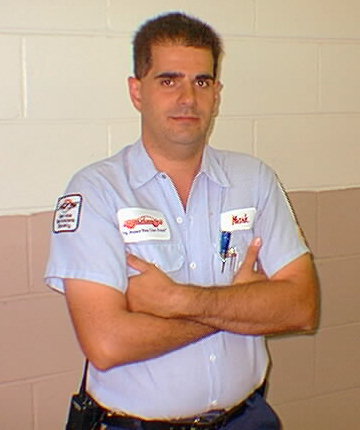 Mark Giammalvo
Mark Giammalvo

|

